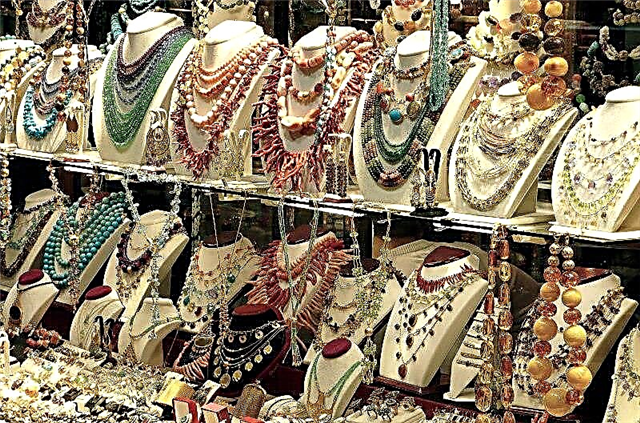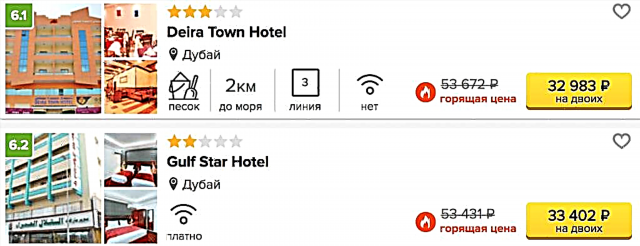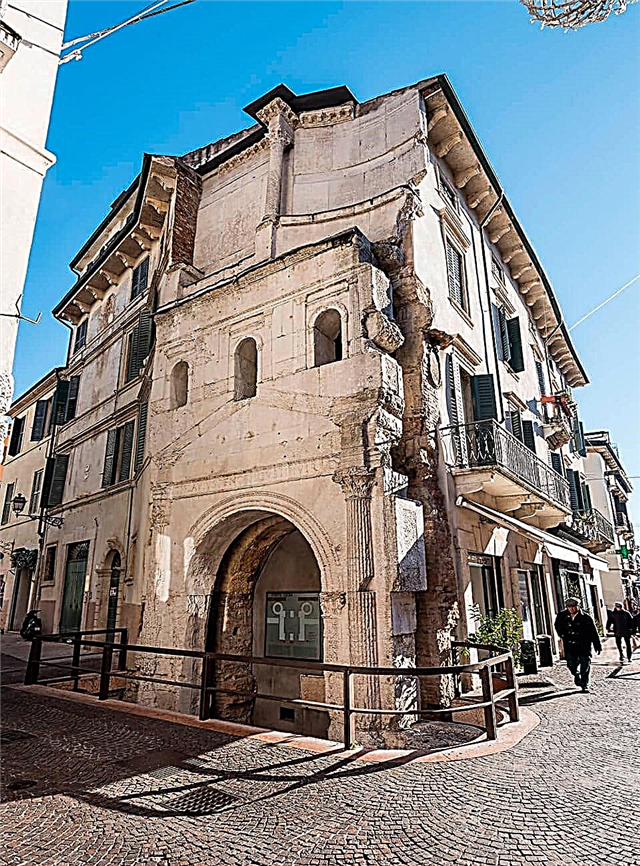What to see in Verona in 1 day on your own? If you have this question, then you are already mentally ready to immerse yourself in the atmosphere of Shakespeare's city of tragic love and its cultural heritage. And this legacy is really diverse - Verona received the status of "little Rome" quite deservedly. We have compiled the best route and highlighted the most interesting places in the city so that you can embrace the immensity in 24 hours.
Church of San Fermo

Hearing about the Basilica of San Fermo, most people think of the masterpieces of the upper church, which is a brilliant example of Gothic architecture. It is in the upper halls that the mausoleum of the Della Torre family is located, the brilliant sculptural group "Lamentation of Christ", frescoes by Pisanello. However, only the lower church retains the spirit of the eleventh century Benedictine order.
The ponderous Veronese Romanesque architecture contrasts with the wooden ribbed ceilings of the upper nave. Here are preserved more ancient frescoes, for example, "Madonna enthroned with a child and two Saints", as well as a number of tombstones, reliably covered with a dense "forest" of pilasters and columns. A standard ticket will cost you 2.50 euros. The church is open from 8:30 to 18:00 in summer and from 10:00 to 17:00 in winter.
Castelvecchio Museum and Castle

On the left bank of the Adige is the brightest example of Gothic architecture of the Scaliger period. Built as a fortification, it served its original purpose until the beginning of the twentieth century, when instead of army barracks it was decided to place museum collections here, which can be seen by paying 6 euros.
Remnants of ancient Roman buildings made of red brick are still preserved here. You will find an extensive collection of Romanesque sculptures. There is also a collection of paintings, the pearl of which is the work of Pisanello. Connoisseurs are guaranteed to be interested in paintings and frescoes from the fourteenth century. The museum is open daily from 8:30 am to 7:30 pm. On Mondays, the working day starts at 13:30.
Giusti Palace and Park

The oldest palace and park complex, Giusti, is imposingly located among the hills on the eastern outskirts of Verona. The local palace is considered atypical due to its location at the foot of the mountain, and not closer to its top. Passing through a closed Romanesque courtyard, you can go to the belvedere and from here enjoy the panoramic view of Verona.
Below there are terraces and an old grotto with a sculptural composition in the center. The lush gardens that surround this exquisite palace are still considered one of the most beautiful of the "Italian" gardens for which the late Renaissance was famous. It is not surprising that this particular park was so fond of Goethe. Today it can be visited for 7 euros. Here is one of the oldest labyrinths in Italy, century-old cypresses, statues and another panoramic platform.
Porta Leoni

The Lion's Gate is considered one of the most ancient city gates of old Verona. Built back in the days of the Roman conquests, they have lost their original name, emerging under different names in different periods of the history of Verona. They got their current name very trite: not far from the gate there is a tomb, which is "guarded" by lions.
Once in front of the double façade, notice the small brick wall that rises next door. This is a fragment of an even more ancient gate. The estimated time of their construction is estimated at the first century BC. Unfortunately, today only the right side of the facade has survived from the port of Leoni. The outer façade has not survived, but the inner façade, clad in white stone and decorated with twisted columns, still faces the Forum of Verona.
Signoria Square

Moving from Piazza delle Erbe, you are guaranteed to find yourself in the historic surroundings of Piazza della Signoria, also known as Piazza Dante. Once it combined the arena for political disputes and the main administrative dominant of the historic center of Verona. The basis of the enchanting architectural complex of the square was formed by the Scaliger arches of the twelfth century, which are stunning examples of the Gothic style.
These ornate royal sarcophagi are located at the Basilica of Santa Maria Antica. The ensemble is complemented by the Council loggia, for the decoration of which only the best craftsmen were always invited, the Palace of Justice with the Lambreti tower and a number of other structures. A sculpture of Dante in Carrara marble overlooking the square from a pedestal.
Scaliger arches

The thin spiers of the arches that adorn Piazza Signori are an instant eye-catcher. Various shades of brown blend organically into the urban landscape of Verona. These Gothic tombstones were inspired by the hanging sarcophagus located near the Church of Santa Anastasia. They immortalized the rulers of the Scaliger family who were in power during the Middle Ages.
The tombstone of Kangrad I is considered one of the most outstanding examples of Veronese sculptural thought. The author of this delicate work remains unknown, although most art historians lean towards Rigino's authorship. The Arch of Cancilorio has a hexagonal outline and is decorated with twisted columns. And finally, the arch of Mastino II is a light construction on which the angels and the deceased ruler himself sit.
Cathedral

One of the most beautiful cathedrals in the city of Romeo and Juliet is the Cathedral of Verona, which combines the features of the Romanesque and Gothic styles. The façade, which is unusually complex in terms of composition, is made of marble and consists of three buttresses. The oldest of them was designed in the eleventh century by Nikolaus. The exterior Romanesque-Gothic design evolves into Baroque and Renaissance interiors.
The entire cathedral is like a painted canvas: white and red marble columns, arches with tympans, prophets and magical creatures, images of the Virgin Mary and the Saints. Particularly noteworthy are the organs, of which there are two in the cathedral. The gilding and intricate carvings are complemented by the painting of the sixteenth century. The entrance ticket price is 2.50 euros. The cathedral is open from 10:00 to 17:30 from Monday to Saturday.
Santa Anastasia

The largest church in Verona belonged to the Dominican order. It is located in the oldest part of the city on the stretch of road by the Ponte Pietra bridge. Once there was another basilica, but at the beginning of the thirteenth century it was handed over to the order, and the construction of a new building began. Externally, the high spire of the bell tower and the sarcophagus of Guglielmo di Castelbarco of the fourteenth century are striking.
Be sure to visit the interior of the basilica - "the hunchbacks of St. Anastasia" - grotesque sculptural compositions as famous as the North Dame gargoyle - any company will be delighted. The floor of the church is also a piece of art - the brilliant mosaic of blue-gray, white and pink marble partially repeats the facing of the portal and is the creation of Pietro da Porlezza.
Verona Card for 24 hours: Arena di Verona skip-the-line and Juliet's balcony - 20 €
Hop-on hop-off bus tour, 24-hour ticket - 20 €
Gardaland amusement park and SEA LIFE: skip-the-line ticket - 39.5 €
Skip-the-line entrance to Lamberti Tower - 8 €
Arch of Porta Borsari

Another antique gate of Verona, partially preserved to this day, was erected as a military outpost in the southern end of the city. The barracks should have been located behind the ancient Roman facade that has come down to us. Already at the time of its creation, the Porta Borsari gate was richly decorated.This was due to their location - at the intersection of the two main streets of Verona, which stretched from south to north and from east to smell. Today, the remains of a small antique courtyard have also survived, which adjoined the gate. If you carefully examine the lower tier of the structures, you will notice the inscription "Colonia Verona Augusta" carved into the stone between the two arched openings. The inscription was made unknown, but dates from the middle of the third century AD.
Maffei Palace

The main decoration of Piazza delle Erbe is the Maffei Palace. It is located on the site of the former Roman forum and the Capitoline Hill. According to the original plan of the fifteenth century, the palace was supposed to be two stories, but eventually the plans were changed, and today the palace has three floors. It is noteworthy that the almost two-century break in construction did not violate the architectural integrity - the baroque pomp was ideal for the richest family in Verona.
A spiral staircase made of stone connects the cellars and the roof. It is noteworthy that it was built without a single support. And on the roof there is an excellently preserved balustrade with sculptures of ancient Roman gods and heroes. Today, Maffei Palace is not a museum. It houses the Palazzo Maffei Verona apartments.
Basilica of San Zeno Maggiore

This masterpiece of the Romanesque style appeared on the architectural map of Verona as early as the seventh century. The monumental building of the basilica became the burial place of bishop Zeno, who was canonized. It is noteworthy that the crypt, where the remains of the bishop are kept, looks really ominous: decayed bones still rest in a transparent sarcophagus, and in the evenings the crypt is illuminated. Bas-reliefs, statues, skillful carving - all this appeared on the facade of the basilica much later than its creation.
The façade itself, made of pink marble and gold tuff, looks majestic and somewhat ponderous. A ticket to the Basilica costs € 2.50. From March to October it is open to tourists from 8:30 to 18:00, on Sundays it opens at 12:30. In winter, the basilica closes an hour earlier.
Piazza delle Erbe

Piazza delle Erbe or Place des Traves nestles comfortably on the ruins of an ancient forum. During the day, it literally boils because of the hundreds of thousands of tourists who want to see with their own eyes the most central square of Verona. Therefore, it is better to postpone the walk until the evening, namely, until Sunday evening. Why exactly until this day? It's pretty simple.
Sunday is the best day to settle in Osteria al Canton with a glass of Italian wine and fully enjoy the beauty of Piazza delle Erbe. After all, it is on Sundays that all kinds of stalls disappear, and nothing prevents us from examining in detail the solemn beauty of the Palazzo Mazzanti, the Lamberti tower, the Madonna's fountain and other dominants of the square.
Wall of love

To get to Juliet's balcony, you will have to dive into a small arched passage, the walls of which, from the ground and almost to the beams, are covered with thousands of declarations of love. There are so many inscriptions that they creep one on top of the other and mix into one multi-colored multilingual mess. The wall appeared as if to counterbalance Shakespeare's tragedies - local Romeo and Juliet meet their happy end or a happy beginning in Verona. Even if you came to Verona without your soul mate, do not be discouraged - many people write here not only confessions, but also wishes for love - for themselves and their loved ones.
Juliet's house

Oddly enough, but the great playwright himself, who gave the world "King Lear", "Hamlet", "Romeo and Juliet" and other ubiquitous plays, has never been to Verona. But fans of the play about lovers, whose misfortune was predetermined by the stars, decided that since the action was to take place in Verona, it was really necessary to find a suitable environment for them. This is how Juliet's house appeared, or rather, the Capello family's house.
Hundreds of thousands of tourists every day rush to a small courtyard, where, under a carved balcony, Romeo in love confessed his feelings. There is also a bronze statue of Juliet, whose right breast must be touched for good luck. You can enter the courtyard for free, but a tour of the house will cost 6 euros. Tours run from 8:30 am to 7:30 pm on all days except Mondays. Juliet's house opens at 1:30 pm on Mondays.
Lamberti tower

This tower continues to maintain the status of the tallest building in Verona, but it was not always so. It was named after the Lamberti family who financed the construction. The skeleton of the future tower was laid back in the twelfth century. Then it was supposed to become part of the Rajone Palace, but during a thunderstorm, the tower was severely damaged by lightning.
During the reconstruction period, as more and more floors were completed, the craftsmen stopped at least trying to imitate the authenticity of the structure: the lower floors are made of a mixture of tuff and brick, above are purely brick medieval walls, and then a marble bell tower. The entrance ticket also includes a visit to the gallery of modern art. The full ticket price is 8 euros. Ticket offices are open Monday through Friday from 10:00 to 17:00 and from 11:00 to 18:15 on weekends.
Arena di Verona

Arena di Verona is a monumental pink marble amphitheater built by the ancient Romans. Today, the Arena is considered the third largest structure of its kind in Italy. And recently she turned two thousand years old! The architects of the past centuries did a great job - the acoustics of the Arena are so perfect that even today it hosts mainly opera concerts.
Connoisseurs admit that the best performances of Romeo and Juliet are always performed at the Arena di Verona. True, such performances are possible only in the warm season. A full ticket will cost you 10 euros. Concert tickets are paid separately. Usually the price ranges from 24 to 100 euros. Tours run from 8:30 am to 7:30 pm. On Mondays, the Arena opens at 13:30.
Palazzo della Ragione and the most photographed staircase

The Palace of Reason is a historical building that, since its construction in the twelfth century, managed to survive several destruction, but at the same time managed to defend its unusual authentic appearance. The square palazzo occupies more than two thousand square meters, which made it one of the largest buildings of the Middle Ages.
Despite the fact that the palazzo is mainly attributed to the Romanesque style of architecture, the facade overlooking the Plaza delle Erbe is made in the neoclassical style, while the second facade has absorbed the features of the High Renaissance. The main tower can only be reached by climbing a huge marble staircase. A visit to the interior, where frescoes, canvases and various sculptures are concentrated, will cost you 8 euros. In summer, the palazzo is open from 11:00 to 19:00, and in winter, the working day is reduced by two hours.
St. Peter's Castle - observation deck

The fortress, erected on the site of a former ancient Roman temple, was named after the Apostle Peter. Its location was not accidental - the hill on which the castle stands is skirted by the Adige River and is high enough to see the whole of Verona. These two qualities were of the greatest strategic value. The modern observation deck offers a truly fantastic view of the city. The castle has been in desolation for many years, and now active restoration work is underway on its territory. According to the current plan, a museum is to be opened under the vaults of St. Peter's castle. The entrance to the castle grounds is free, but count on a rather grueling climb - the funicular has not been operating for many years.
Travel tips from a local
- While walking in Verona, carefully look not only at your feet, but also upwards.
- If you want to find places that locals visit, don't be afraid to get off the hiking trails and delve into the side streets.
- Only go to via Mazzini if you are planning to do some shopping.
- If you want to visit as many museums as possible, but at the same time spend only time, plan your trip so that it falls on the first Sunday of the month. On this day, admission to most museums is free or for a purely symbolic fee.
- Consider the design of VeronaCard if you are planning a more eventful sightseeing vacation. There are different types of cards. The most popular are designed for 24 and 48 hours. The first will cost 18 euros, the second 22. A similar card allows you to visit twenty attractions: the Arena di Verona, Juliet's house, the Basilica of St. Anastasia and other tourist places.











